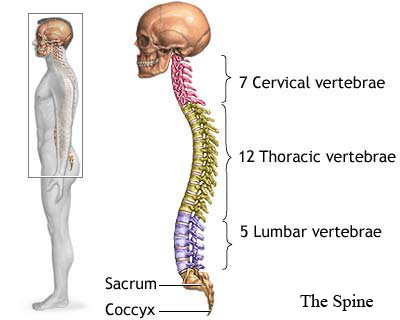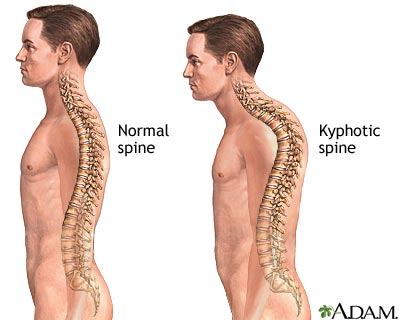In today’s post, I’m taking a brief look at kyphosis, and the role of thoracic mobility in quality movement.
When you look at the spine from side on, you will observe a series of curves. The cervical spine (neck) and the lumbar spine (lower back) naturally curve inward, called lordosis. The thoracic spine (upper back) naturally curves outward, called kyphosis. For the purposes of this post, the term kyphosis will be used to refer to abnormal, excessive, postural kyphosis.
One of the most common structural faults I see in the gym is kyphosis. Rounded shoulders and an exaggerated thoracic curve are an epidemic in offices across the world. Two common causes of kyphosis are muscular imbalances and poor posture. Spend enough time slumped over a desk and you will probably find yourself somewhat hunched forward. Muscular imbalances that can cause and exacerbate kyphosis occur when your scapular protractors such as the pecs and serratus anterior (which pull the shoulders forward) become shortened and tight, while your scapular retractors such as the trapezius and rhomboids (which pull the shoulders back) become weakened and lengthened.
So what does this all mean for CrossFitters? Overhead movements such as the press, overhead squat, American kettlebell swing and jerk demand good thoracic mobility. If your shoulders are tight and/or you suffer from kyphosis, these movements are going to be difficult, if not impossible. Kyphosis means poor thoracic mobility. Thoracic immobility means bad shoulder mechanics. If you lack thoracic mobility, you will not be able to achieve proper shoulder alignment as you try and press overhead and run the risk of painful impingement. Another common fault caused by thoracic immobility is compensating by overextending or arching the lower back in order to push a bar directly overhead. This is not a safe position to be in and eventually something’s got to give.
Here’s a quick test to determine whether you have okay thoracic mobility.
- Lay on your back with your feet and glutes flat on the floor, arms straight by your sides.
- Keeping your shoulders down, suck your belly button down to your spine and flatten your lower back into the ground.
- Slowly, keeping your arms straight, bring your arms overhead and try and make contact with your wrists and the floor.
- Do not arch your back. Keep it flattened into the ground.
If you are incapable of doing this or had to work for it, you probably have poor thoracic mobility.
If you suffer from severe kyphosis and muscular imbalances, I would highly recommend working with a PT or chiropractor to address these. If things aren’t working like they should, a few mobility exercises aren’t going to cut it and personalized treatment would be advisable. This detailed article from T-Nation also provides some useful corrective exercises.
That said, improving thoracic mobility is an important step in preventing and lessening kyphosis. Even if you do not have a glaring problem, every CrossFitter can benefit from working on thoracic mobility. I know I get awfully tight in the upper back, particularly when doing a lot of strength work. The exercises below address two aspects of thoracic mobility, extension and rotation. To think extension, imagine someone with a hunched upper back trying to stand straight. The thoracic, not the lumbar, is what we should use to rotate side to side. Improving thoracic rotation mobility will prevent you from rotating with the lower back, which can cause pain and instability.
Thoracic Extension:
Kelly Starrett uses a double lacrosse ball or ‘peanut’ to increase extension, adding a weight plate at the end to keep the ribcage down:
http://www.mobilitywod.com/2012/05/a-better-upper-back-extension-izer/
My favorite extension drill is foam rolling.
[youtube http://www.youtube.com/watch?v=PFWUEktnM3c&w=560&h=315]
Thoracic Rotation:
Quadruped thoracic rotation/extension
[youtube http://www.youtube.com/watch?v=ono1hPKZsiE&w=420&h=315]
Open book thoracic rotation
[youtube http://www.youtube.com/watch?v=wPnFgg9hk6Y&w=560&h=315]
If you know you are very tight, do these exercises every day, multiple times. Improving thoracic mobility will be extremely beneficial to your performance at CrossFit, particularly to those who work a desk job and more likely than not, are afflicted by mild postural kyphosis and shoulder tightness.














































[…] on your thoracic mobility. Poor thoracic mobility means more stress on your […]
[…] Couple this shoulder stretch with thoracic mobility exercises to improve your overhead position. Click here for a previous post on thoracic mobility. […]